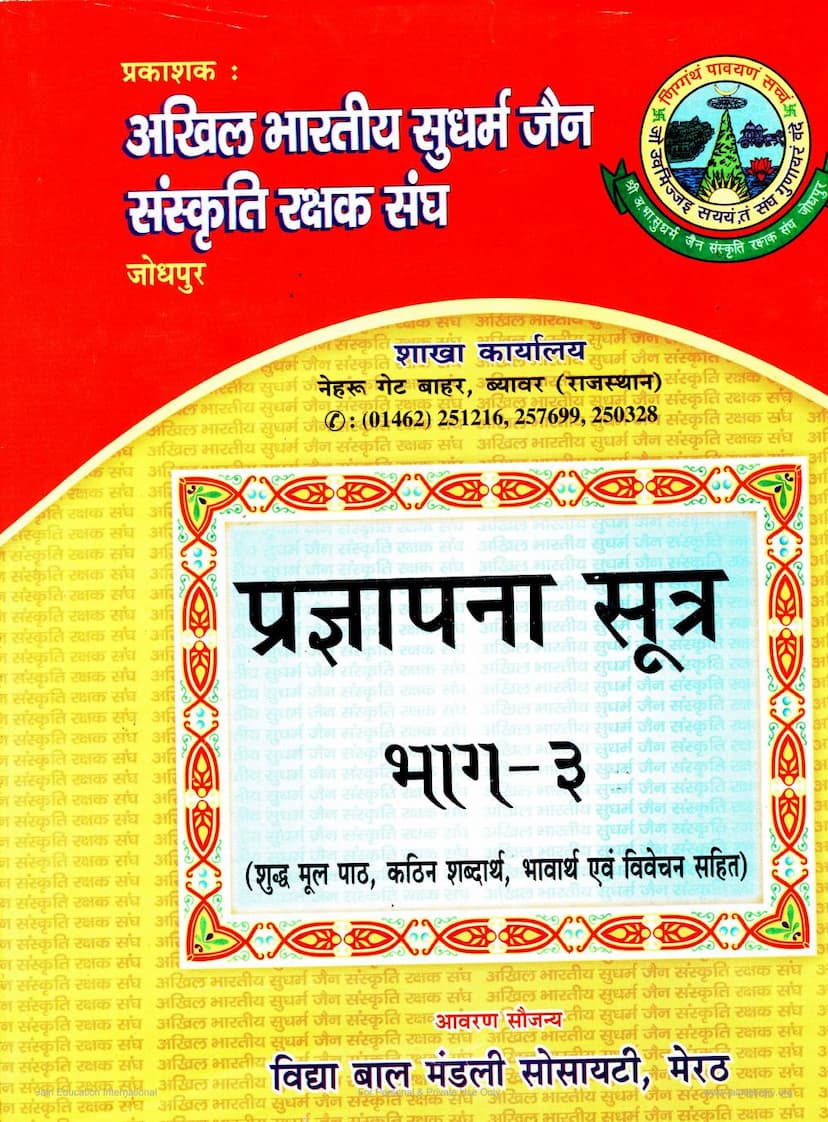Pragnapana Sutra Part 03
Added to library: September 2, 2025

Summary
This document is the third part of the Prajnaapana Sutra, a significant Jain Agama text. It covers texts from Pad 13 to Pad 21. The book is published by Akhil Bharatiya Sudharm Jain Sanskruti Rakshak Sangh, Jodhpur, and edited by Nemichand Banthiya and Parasmal Chandaliya.
Here's a breakdown of the content covered in this part:
Key Themes and Concepts:
- The Prajnapana Sutra's Significance: The introduction highlights the Prajnapana Sutra's importance in Jain Agamic literature, comparing its status among Upanga Sutras to that of the Bhagavati Sutra among Anga Sutras. It notes that many other Agamas refer to the Prajnapana Sutra for detailed explanations of their topics, indicating its comprehensive nature.
- Meaning of "Prajna": The term "Prajna" is explored, distinguishing the Agama's meaning of inner consciousness-awakening knowledge from the common understanding of "intellect" or "wisdom."
- Authorship: The text attributes the authorship of the Prajnapana Sutra to Acharya Kalakacharya (Shyamacharya), placing its creation between 335 and 376 Vir Nirvana Samvat.
- Structure of the Sutra: The Prajnapana Sutra is described as the largest Utkalika Sutra among Upanga Sutras, divided into 36 chapters called 'Padas'. This part specifically covers Padas 13 to 21.
- Content of the Padas (13-21):
- Pada 13: Parinama (Change/Transformation): This pada discusses the concept of "parinama" (change or transformation) as understood in Jain philosophy, explaining that it's not total destruction but a change of state or form. It categorizes "parinama" into two main types: Jiva Parinama (results of the soul's transformations) and Ajiva Parinama (transformations of non-living matter).
- Jiva Parinama is further detailed into ten categories: Gati (destination), Indriya (senses), Kashaya (passions), Lèshya ( Karmic color), Yoga (activity), Upayoga (consciousness), Jnana (knowledge), Darshana (perception), Charitra (conduct), and Veda (sex). The text elaborates on each of these, explaining their types and how they manifest in different beings.
- Ajiva Parinama is categorized into ten aspects: Bandhana (bondage), Gati (movement), Samsthana (form), Bheda (division), Varna (color), Gandha (smell), Rasa (taste), Sparsha (touch), Agurulaghu (weight), and Shabda (sound). The text delves into the nature and types of these transformations in inanimate matter.
- Pada 14: Kashaya (Passions): This pada focuses on the four Kashayas – Krodha (anger), Mana (pride), Maya (deceit), and Lobha (greed) – explaining their nature, causes, and manifestations in different life forms. It emphasizes Kashaya as a primary cause of karmic bondage.
- Pada 15: Indriya (Sense Organs): This extensive pada analyzes the five sense organs: Shrotra (hearing), Chakshu (sight), Ghrana (smell), Jihva (taste), and Sparsha (touch). It describes their number, types (dravya and bhava indriya), form (samsthana), extent (bahalya, prithutva), number of subtle particles (pradesha), placement (avagadha), relative quantity (alpabahutva), whether they are 'spṛṣṭa' (touched) or 'aviṣṭa' (untouched) by their objects, and their range of perception (vishaya). It also discusses the concept of 'anagara' (ascetic) in relation to senses and 'ahara' (nourishment).
- Pada 16: Yoga (Activity): This pada explores the concept of "yoga" or activity, classifying it into three types: Mana Yoga (mental activity), Vachana Yoga (verbal activity), and Kaya Yoga (bodily activity). It further details various forms of these activities, including those related to different types of bodies (audārika, vaikriyaka, āhārakā, taijasa, kārmaṇa) and their modifications.
- Pada 17: Lèshyā (Karmic Coloration): This pada elaborates on the six types of Lèshyā: Krishna (black), Nila (blue), Kapota (dove-colored), Tejo (fiery), Padma (lotus-colored), and Shukla (white). It discusses the presence of these Lèshyās in various life forms (Jivas) and the associated outcomes or qualities. It also touches upon the concept of 'avagahana' (depth/extent) and 'samsthana' (form) in relation to Lèshyās.
- Pada 18: Kāyasthiti (Duration of Body/Existence): This pada delves into the concept of "kāyasthiti," which refers to the duration of a soul's existence in a particular body or state. It examines this duration across various life forms and rebirths, including the time spent in different states like being insufficient for a body (aparyāpta) versus sufficient (paryāpta), and the continuation of existence in different states (e.g., one-sensed, two-sensed, etc.).
- Pada 19: Samyakva (Right Faith/Perception): This pada discusses the different types of "dr̥ṣṭi" (perception or viewpoint) in Jainism: Samyak-dr̥ṣṭi (right perception), Mithyā-dr̥ṣṭi (wrong perception), and Samyag-mithyā-dr̥ṣṭi (mixed perception). It analyzes which life forms can possess these types of perceptions.
- Pada 20: Antakriyā (Cessation/End of Action): This pada explores the concept of "antakriyā," referring to the actions that lead to the cessation of karmic influx and ultimately to liberation. It examines how different life forms engage in such actions and their potential outcomes.
- Pada 21: Avagāhanā-Samsthāna (Extent and Form): This pada focuses on the physical characteristics of bodies across different life forms, describing their extent (avagāhanā) and form (samsthāna). It provides details on the dimensions and shapes of various bodies, from the subtle carnal body to the gross physical bodies.
- Pada 13: Parinama (Change/Transformation): This pada discusses the concept of "parinama" (change or transformation) as understood in Jain philosophy, explaining that it's not total destruction but a change of state or form. It categorizes "parinama" into two main types: Jiva Parinama (results of the soul's transformations) and Ajiva Parinama (transformations of non-living matter).
Publisher's Role: The publication by Akhil Bharatiya Sudharm Jain Sanskruti Rakshak Sangh, Jodhpur, indicates their commitment to preserving and disseminating Jain scriptures. The mention of the third edition suggests the popularity and continued interest in this text. The acknowledgment of contributors like Shri Jasvantlal Bhai Shah highlights the collaborative effort in bringing such works to light.
Overall Purpose: This volume of the Prajnapana Sutra, covering Padas 13-21, appears to be a foundational text for understanding Jain metaphysics and cosmology, particularly concerning the nature of the soul, its transformations, karmic influences, the functioning of senses, the duration of existence, the role of correct perception, actions leading to liberation, and the physical attributes of beings across different realms of existence. The detailed explanations of these concepts are crucial for Jain monks and scholars for spiritual practice and philosophical understanding.